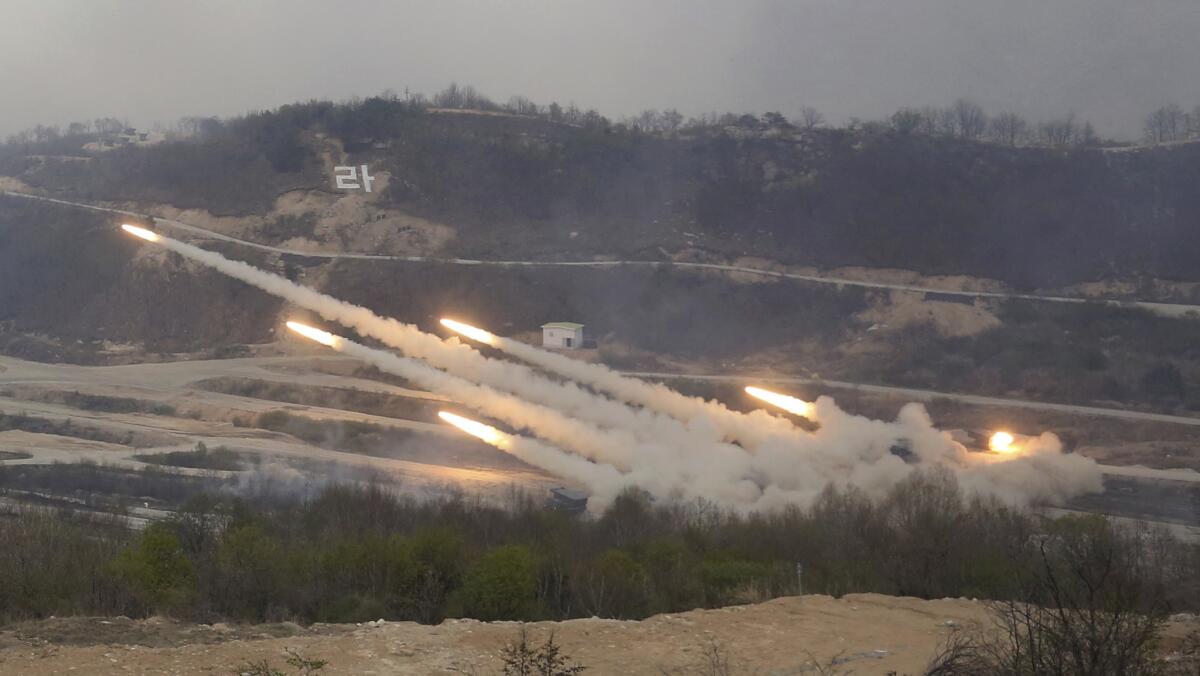U.S. sets up missile defense in South Korea as North shows power

- Share via
Reporting from SEOUL, South Korea — Hours after a display of North Korean military power, rival South Korea announced Wednesday the installation of key parts of a contentious U.S. missile defense system meant to counter the North.
South Korea’s trumpeting of progress in setting up the Terminal High-Altitude Area Defense system, or THAAD, comes as high-powered U.S. military vessels converge on the Korean Peninsula and as a combative North Korea signals possible nuclear and missile testing.
North Korea conducted live-fire artillery drills on Tuesday, the 85th anniversary of the founding of its million-person Korean People’s Army. On the same day, a U.S. guided-missile submarine docked in South Korea. And the USS Carl Vinson aircraft supercarrier also is headed toward the peninsula for a joint exercise with South Korea.
The moves to set up THAAD within this year have angered not only North Korea, but also China, the country that the Trump administration hopes to work with to rid the North of nuclear weapons. China, which has grown increasingly frustrated with North Korea, its ally, and Russia see the system’s powerful radars as a security threat.
South Korea said in a statement Wednesday that unspecified parts of THAAD were installed. It said that Seoul and Washington have been pushing to get THAAD quickly working to cope with North Korea’s advancing nuclear and missile threats. According to the Yonhap news agency, the parts include two or three launchers, intercept missiles and a radar.
Some people near the site in the country’s southeast are worried that THAAD may cause health problems, and thousands of police officers assembled Wednesday, blocking the main road, Yonhap reported. About 500 protesters rallied, and 13 villagers and police officers were injured in scuffles and treated at hospitals, reportedly for broken bones, according to the Seongju fire department.
Chinese foreign ministry spokesman Geng Shuang said Wednesday that the system’s deployment would “disrupt the regional strategic balance and further aggravate the tension on the peninsula.”
Geng said that “China will firmly be taking necessary measures to defend our own interests,” but he offered no details. China’s defense ministry also has repeatedly criticized THAAD’s deployment and said the military will take unspecified actions in response.
On Tuesday, North Korea conducted what it called its largest combined live-fire drills, near the east coast port city of Wonsan.
North Korea’s official media reported Wednesday that leader Kim Jong Un personally observed the exercises, which involved the firing of more than 300 large-caliber artillery pieces and included submarine torpedo-attacks on mock enemy warships.
Along with sending U.S. military assets to the region in a show of force, President Trump is leaning on China to exert economic pressure on North Korea. Chinese President Xi Jinping, who spoke to Trump on Monday, is urging restraint from both North Korea and the U.S.
In Washington, top Trump administration officials are scheduled to brief the entire U.S. Senate on Wednesday. A rapid tempo of North Korean weapons testing in the past year has pushed Kim Jong Un’s authoritarian nation closer to developing a nuclear-armed missile that could reach the U.S. mainland.
Republican Sen. Lindsey Graham of South Carolina voiced confidence that Trump won’t allow North Korea to reach that point. Graham, a defense hawk who dined with Trump on Monday night, said North Korea should not underestimate the president’s resolve.
The USS Michigan, a nuclear-powered submarine, arrived Tuesday at the South Korean port of Busan for what was described as a routine visit to rest crew and load supplies. The U.S. 7th Fleet said two American destroyers were conducting simultaneous maritime exercises with naval ships from South Korea and Japan.
North Korea routinely accuses the United States of readying for an invasion and threatens preemptive strikes to stop it. An unidentified North Korean Foreign Ministry spokesman said the U.S. administration’s policy to maximize pressure on North Korea was “little short of lighting the fuse of total war,” the state news agency reported Tuesday.
The streets of Pyongyang, however, were quiet for Tuesday’s anniversary, which was overshadowed by April 15 celebrations of the birthday of the nation’s late founder, Kim Il Sung, and were marked by a missile test the following day.
On Friday, U.S. Secretary of State Rex Tillerson is to chair a special meeting of the U.N. Security Council.
Tillerson will be “very vocal” about nations enforcing sanctions on North Korea, State Department spokesman Mark Toner said. Trump said Monday the council must be prepared to impose stronger sanctions.
ALSO
North Korea has detained a U.S. citizen, potentially raising tensions
Trump said Navy ships were headed toward North Korea. They were going the other way
More to Read
Sign up for Essential California
The most important California stories and recommendations in your inbox every morning.
You may occasionally receive promotional content from the Los Angeles Times.










